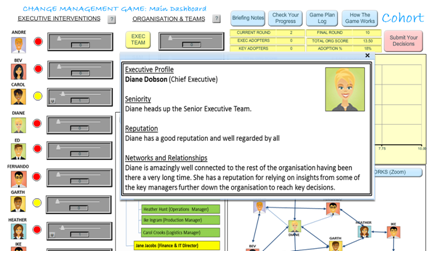Playing to Learn: Bioteams Design uses iThink to create games that teach important business lessons
 Ken Thompson
Ken Thompson
When Simon Brocket, Group Human Resources Director of Twinings, the international brand known for its Premium Teas and Ovaltine Malt drinks, wanted his staff to learn more
deeply about their business in order to maximize their organizational value, they could have read papers or attended presentations. Instead, they played a game.
“If you don’t run the business you work in, you look at the decisions that are being made and think ‘Why are they doing that when they could be doing this?” says Ken Thompson,
CEO of Bioteams Design and developer of the Twinings game. “Games and simulations allow people to experience the difficulty of decision making. The HR teams from Twinings
quickly realized that growing revenue and maximizing profits, for example, are very different and hard to do at the same time. They not only learned about their business,
they built even more respect for their business leadership teams.”
Thompson began creating games five years ago when a client requested one to use for a team building exercise. He was the right person to ask. Having served as the CEO of a
leading Irish consultancy that helped clients build effective business teams, Thompson decided he wanted to get back to hands-on work with clients. He took a sabbatical and
studied what nature can teach businesses about work teams. That sabbatical produced a book, Bioteams: Higher Performance Teams Based on Nature’s Most Successful Designs, and
inspired Thompson to start Bioteams Design.
In the past three years, more and more businesses have been looking for fun approaches to new employee training, skills improvement, and team building
“People usually study nature to get ideas for inventions,” says Thompson. “A Scot’s observation that thistles stuck to his dog’s fur led to Velcro. That’s called biomimicry.
I looked at the ways teams work in nature to learn lessons that would apply to business teams. For example, successful teams that occur in nature often have multiple leaders.
Besides his experience as a team building consultant and interest in biomimicry, Thompson brings an affinity for mathematics and long tenure with iThink to the table for his
clients. “I really like both collaboration and math,” says Thompson, “and the games I design have social and business elements. In the past three years, more and more businesses
have been looking for fun approaches to new employee training, skills improvement, and team building. Developing games and simulations with iThink has been a great answer.”
Working in partnership with leading change management consultancies such as Lane4 who introduced Twinings to Thompson, his development process turns out games and simulations
tailored to the unique goals of businesses. “All games are based on business dilemmas but they are inevitably customized,” explains Thompson. “I find a subject matter expert
(SME) at the client company who can explain the business rules, teach me the corporate language, and provide access to actual data. Using iThink I can build the first draft
of the game pretty quickly. Then, with the subject expert, I build iterations and conduct testing over a six-week period. The subject matter expert also comes to the game
sessions so that when questions come up – ‘Why does this work this way?’ – the answers are based on what actually happens in the company.”
The Twinings game required players to run the business for three years. The object of the game was to simultaneously increase revenue, maximize profits, and expand markets.
“Most games ask players to accomplish something similarly difficult,” says Thompson. “I usually develop three rounds. The first round is fairly easy. Players learn how the
game works and build confidence. The second round is usually really hard. Maybe markets change or supplier prices go up or competitor prices go down. All three things could
happen at once. In the third round we try to build confidence again to maximize the learning.”
Players learned the importance of challenging assumptions when making business decisions
While all businesses are different, Thompson’s clients do have very similar game experiences. For example, they often recognize “golden rules” that are consistently applied
but inconsistently successful. “Golden rules – I’ll never do this, I’ll always do that – are originally based on conditions that, after the rule has been applied 3 or 4 times,
are forgotten,” says Thompson. “Maybe a company always buys a brand of laptop even though they can’t remember the conditions that made that a good decision. Golden rules get
stronger and stronger over time.”
Players recognize those golden rules as they work through games and simulations; often because they reflexively apply them with poor results. “The Twinings game showed that
many business people thought new product development was always to be used offensively for market building rather than defensively for cost reduction,” says Thompson. “We
deliberately set it up so it didn’t work like that in the game and players learned the importance of challenging assumptions when making business decisions.” Other parts in
the game showed players that increasing prices doesn’t solve all dilemmas – it is possible to push prices too high.
Thompson’s newest game explores change management. It requires players to change the minds of ten key executives in order to move the company in a new direction.
 Change Management Game: Main Dashboard
Change Management Game: Main Dashboard
“I always get excited by the project that’s in front of me so I’m excited about this right now,” says Thompson. “The game looks at the whole business system but it also
requires players to think about the impact of one intervention. If they can change the mind of one key executive, they can get buy-in from other executives.”
The combination of a whole system view and specific actions within parts of the system is inherent in most meaningful games, and that is what makes iThink Thompson’s
development tool of choice. “iThink has also allowed users to take a system dynamics view and an agent-based view using its powerful array capabilities of, for example,
a single conversation with an executive,” he says. “A system dynamics perspective considers behavior of the whole system. An agent-based view shows you the interactions
between the “agents” which make up the system. iThink combines both views into a single hybrid model that is much more powerful than models that offer just a single view.”
I can throw new problems or conditions at players to get them to change their approach. Those aren’t things you can do with a spreadsheet
iThink also lets players remake decisions and see the impact of those decisions over time. “I can throw new problems or conditions at players to get them to change their
approach,” explains Thompson. “Those aren’t things you can do with a spreadsheet.”
isee systems’ NetSim allows Thompson to easily share his games among multiple participants without having to install software on their laptops. His games often take
advantage of audio, video, images and other content to explain how the game is played, describe a player or team’s progress, or provide context.
“Clients love games that are based on their own businesses,” says Thompson. “They’ve been great tools for getting people to think about operations management and change
management or learn new skills together, often from each other, in order to build strong, successful business teams.”